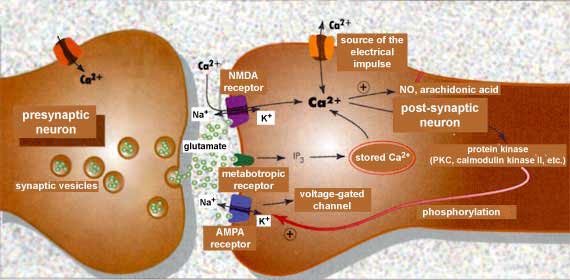Thanks to research by hundreds of laboratories throughout the world, the main entities involved in synaptic transmission have now been identified. They include over sixty neurotransmitters and hundreds of subtypes of receptors. Since a single neuron may release several different neurotransmitters at once, the soup of molecules and ions in the synaptic gap can be decoded only by means of very specific affinities between neurotransmitters and their receptors.
A combination of neurotransmitters that can
act on various subtypes of receptors can thus have varying effects,
depending on what particular receptors they are acting upon.
This diagram shows a synapse that is capable
of long-term
potentiation, a synaptic facilitation mechanism that is the
basis for memory. The neurotransmitter involved here is glutamate.
The enlarged diagram shows just three of the approximately twenty
known subtypes of glutamate receptors.

When glutamate binds to these receptors,
it not only causes the ion channels to open but also triggers several cascades
of chemical reactions, also represented in this diagram. Many
of these reactions involve “second messengers:” molecules
that relay signals from neurotransmitters within the postsynaptic
neuron and that can in turn cause other ion channels to open or
close. The effects of second messengers can extend all the way
to the neuron’s nucleus, thus influencing its synthesis of
new proteins, receptors, or channels, for example.
|
|
|
To be considered a neurotransmitter, a molecule must meet several criteria.
1) It must be produced inside a
neuron, found in the neuron’s
terminal button, and released into the synaptic gap upon the
arrival of an action potential. 2) It must produce an effect
on the postsynaptic neuron. 3) After it has transmitted its signal
to this neuron, it must be deactivated rapidly. 4) It must have
the same effect on the postsynaptic neuron when applied experimentally
as it does when secreted by a presynaptic neuron.
Over 60 different molecules are currently known to meet these
criteria.
|
Read more...